By Marty Gallagher
Develop Strong Legs
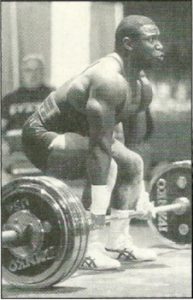
Sly Anderson demonstrates perfect start position for conventional deadlift. He will use leg power to break the 766 pound bar from floor to his knees. Weak-legged lifters might assume this position but at takeoff allow the tailbone to shoot upward to put weak legs in a more advantageous push position. Problematic, the weak-legged lifter makes a devil’s bargain and takes the easy start in return for an excruciating, spine-killing finish. Great deadlifters embrace the hard start in return for the easy finish. Note vertical shins that allow for straight up pull.
Key Technical Points
- To build a superior deadlift build superior leg strength.
- Deadlift technical flaws are related to weak legs in relation to back.
- Weak legs send a signal to brain, “we need help!”
- The brain responds: “allow the hips to rise.”
- High hips places legs in better push position.
- High hips decrease the thigh push stroke.
- This is “avoidance compensation.”
- The solution is to develop leg power.
- Weak legs place increased stress on the spinal column.
- The lower back is used as the prime mover instead of the legs.
- The perfect deadlift is a muscular relay race.
- Legs start the pull, lower back takes over, upper back completes the lift.
- Good deadlifters trade the hard start for the easy finish.
- Bad deadlifters take the easy start in return for the excruciating finish.
- Good deadlifter contort body to accommodate straight line upward pull.
- Bad deadlifters make barbell conform to their out-of-position body.
- When completing the perfect deadlift, everything “arrives at once.”
- Imperfect deadlifts lock out legs first.
- Spine then derricks out-of-position payload poundage into place.
Kettlebell Sumo Deadlift
Key Technical Points
- Think of the kettlebell and barbell Sumo deadlift as a “reverse squat.”
- Assume your squat stance with a kettlebell placed between feet.
- Squat down – don’t bend over – arms hang straight down.
- Grasp kettlebell with both hands.
- Inhale on descent, exhale on ascent.
- Come erect with limp arms, upright torso.
- Lockout completely.
- Descend with ever-increasing muscle tension.
- Touch the floor lightly with bell bottom – do not loose muscle tension.
- The instant bell touches floor, reverse direction.
- Come erect and lockout fully.
- No bouncing the bell off the floor at the turnaround.
- Observe all squat rules: erect torso, knees over ankles, knees forced out
Sumo Deadlift
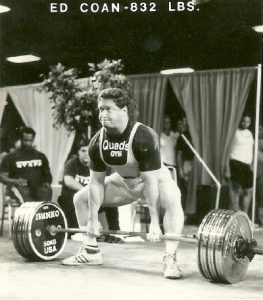
Ed “King” Coan: the greatest powerlifter of all time. Ed pulls straight up to break the bar from floor. Coan deadlifted 901 weighing 219; pound-for-pound the greatest powerlift of all time. I was his competition coach for a decade.
Key Technical Points
- Place barbell loaded to 135 pounds at your feet, vertical shins touch bar.
- Squat down – don’t bend over; grip barbell between thighs; narrow grip.
- Do NOT set hips high – this causes “spinal derricking.”
- Knees over ankles; shoulders over bar – not in front.
- Tense entire body – break bar from floor using leg power alone.
- Do not let the tailbone shoot up at takeoff.
- Bar is pulled upward in a straight line; everything “arrives at once.”
- Inhale while descending.
- Weight plates lightly touch floor; when plates touch begin upward pull on next rep.
Conventional Deadlift
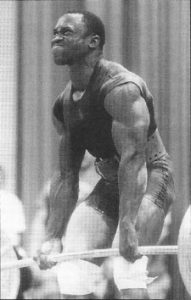
Gene “The Machine” Bell has embraced the difficult start and is now in perfect position to reap the reward of an easy finish. Bell, world champion and world record holder, has pulled the 800 + bar from floor to knees using leg power. He now simply drives his hips forward to finish the lift. In a perfect deadlift, sumo or conventional, shoulders never get in front of the bar: the ‘over-under’ hand grip improves grip strength by 30%. Bell, as does every great deadlifter, pulls the bar upward in a straight line and contorts his body to accommodate the straight-line pull. Bad deadlifters make the bar contort to their out-of-position body.
Key Technical Points
- Place barbell loaded to 135 (or more) at your feet.
- Stance width is 8-12 inches between heels, no more.
- Squat down with vertical shins.
- Grasp barbell with hands slightly outside legs using over/under grip.
- Shins and torso are as vertical as possible.
- Optimally, the torso and shins maintain position; only the femurs move.
- Pull barbell upward in a straight line.
- Everything locks out simultaneously.
- Improper deadlift locks legs out first, then the torso is derricked erect.
- Inhale on the descent: load more tension as bar approaches floor.
- Olympic plates touch lightly and evenly on floor.
- Begin the upward pull the instant the plates touch.
- Squat down; don’t bend over on subsequent repetitions.
Deadlifting with Straps
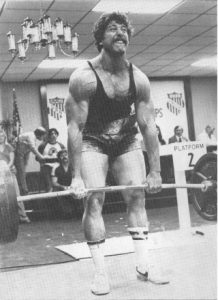
Mark Chaillet pulls 835 weighing 219 in 1980. Mark was my training partner for six years. The barbell has gotten out of position on him; his legs are straight yet the poundage is not locked out, leaving him in the unenviable position of having to derrick 835 to lockout. His best all-time lifts were an 880 deadlift and a 1,000 pound squat. Mark was King of minimalistic training. His routine never varied: on Monday he would work up to a single rep in the squat and bench press. On Thursday he would work up to a single rep in the deadlift. Each week for 12 weeks he would push upward 20 pounds in the squat and dead, 10 in the bench press. Mark never performed any other lifts of any kind! He was one of history’s great deadlifters and showed how much power could be built with so little time invested.
Key Technical Points
- Follow technical point of sumo and conventional deadlift using weightlifting straps.
- Straps allow overload: turn a single into a triple, a 3 into a 5, a 5 into an 8.
- Learn how to adhere straps smoothly and effortlessly.
How to Periodize
In the world of strength training the use of periodization is standard operating procedure and should become an integral part of your training. Periodization is another word for preplanning. Elite strength athletes will lay out 3-4 months of preplanned workouts ahead of time; identifying target poundage, number of sets and reps for each and every workout.
Hall of Fame lifter (and current world record holder) Kirk Karwoski and I would lay out his periodized training template twice a year: before the national championships and world championships. For the last few years of his career he was able to complete an entire 12-week periodized game plan without missing a single preplanned set, rep and poundage target. Other greats such as Ed Coan and Doug Furnas were equally adept.

Kirk Karwoski squats 1003 pounds at the 1995 Nationals.
Here is how an individual with a 200 pound squat, a 150 pound bench press, a 300 pound deadlift and a 100 pound overhead press might lay out a 12 week periodized game plan. Each set and rep combination is performed after taking as many warm-up sets as needed.
This template can be modified and utilized regardless current strength levels.
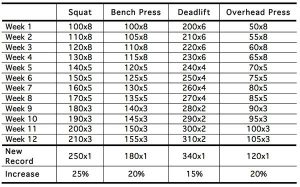
Key Points
- All lifts start off at approximately 50% to 65% of current max
- All lifts end up roughly 15% to 25% above current max
- All lifts utilize pristine technique
- Optional: In early phases, multiple top sets can be used
- Never start off too high or too low
Creating Your Own
Periodized Training Template
In a nutshell, the way to periodize or “cycle” any lift is as follows….
- Create a realistic goal
- Establish a realistic timeframe
- Reverse engineer: work backwards with a calendar, pen and legal pad
- Place the realist goals within a specified timeframe
- Work backwards to establish weekly poundage benchmarks
- Every 3-4 weeks alter the variables in anticipation of stagnation
- When instituting changes, make them dramatic, not minor
Scenario: let us assume a 195 pound individual is athletic, but slightly out-of-shape coming off the winter holidays; he wants to take ten weeks to lean out and shape up. His previous deadlift best was 390×1 and his leanest, most athletic and functional bodyweight in the past has been 185-188 pounds.
In ten weeks time our hypothetical individual has morphed from a soft 195 into a rock hard 180 pounds. His deadlift, a great overall strength indicator, has leapt upward by a full 10%, from 390 for 1 rep to 435 for 1. He has regained his cardio condition by tweaking his run durations and weekly frequencies. In 70 days he has gotten himself into prime fighting condition. This is a fairly conservative example and mirrors what I do with clients and students every single week.
